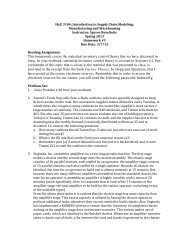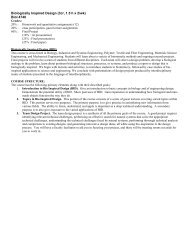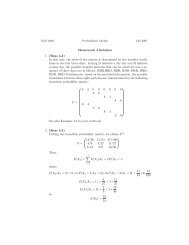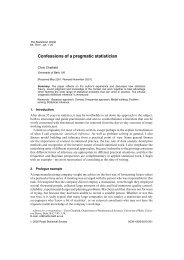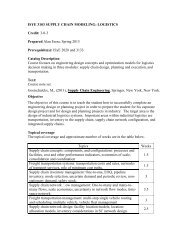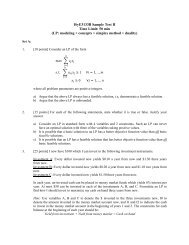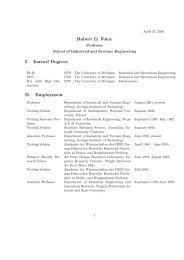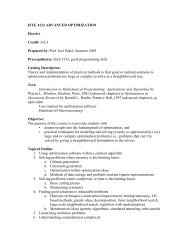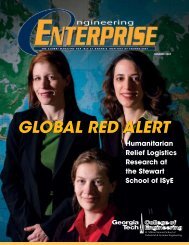Fall 2009 - H. Milton Stewart School of Industrial & Systems ...
Fall 2009 - H. Milton Stewart School of Industrial & Systems ...
Fall 2009 - H. Milton Stewart School of Industrial & Systems ...
You also want an ePaper? Increase the reach of your titles
YUMPU automatically turns print PDFs into web optimized ePapers that Google loves.
ON THE MOVE<br />
Transportation Logistics at ISyE<br />
Moving the World with Ocean Cargo<br />
By Alan Erera and Ozlem Ergun<br />
Beginning in the latter stages<br />
<strong>of</strong> the twentieth century, the<br />
forces <strong>of</strong> globalization that<br />
reshaped industrial supply<br />
chains were influenced by two primary<br />
factors: the very large differential<br />
in labor costs between developed<br />
and developing countries and the<br />
availability <strong>of</strong> high volume, inexpensive<br />
international freight transportation.<br />
When it comes to moving finished<br />
goods and intermediate products<br />
between continents to consumers and<br />
businesses, the dominant mode <strong>of</strong><br />
transportation is containerized ocean<br />
cargo. In fact, since the early 1990s, the<br />
use <strong>of</strong> container shipments worldwide<br />
has grown more than three times the<br />
rate <strong>of</strong> the global GDP. Despite the<br />
recent economic downturn that has<br />
significantly cooled international trade,<br />
it is likely that ocean container cargo<br />
will continue to be important for years<br />
to come.<br />
Researchers within the <strong>Stewart</strong><br />
<strong>School</strong> have been active in ocean cargo<br />
research throughout the past decade.<br />
In this article, we highlight two recent<br />
research efforts supported by both<br />
the National Science Foundation and<br />
the Singapore Economic Development<br />
Board.<br />
Pr<strong>of</strong>essor Ozlem Ergun and Richa<br />
Agarwal (PhD IE 2007) recently<br />
completed a set <strong>of</strong> work culminating<br />
in Agarwal’s thesis, “Network Design<br />
and Alliance Formation for Liner<br />
Shipping.” Today’s large ocean carriers,<br />
like Maersk, Hapag Lloyd, and NOL,<br />
face challenging problems in service<br />
network design, the task <strong>of</strong> determining<br />
which routes or services to operate and<br />
at what frequencies and how to assign<br />
ships to these services. An important<br />
new challenge is that most transoceanic<br />
routes today are operated jointly by a<br />
number <strong>of</strong> different carriers working<br />
together within an alliance. Thus,<br />
the research also focuses on how to<br />
jointly plan the operations <strong>of</strong> multiple<br />
collaborative carriers, including how<br />
to allocate the capacity <strong>of</strong> different<br />
services among carriers.<br />
To solve these problems, Agarwal<br />
and Ergun developed a new integrated<br />
optimization model to solve the ship<br />
scheduling problem and the cargo<br />
routing problem simultaneously—the<br />
first such model to incorporate<br />
transshipment ports (where cargo<br />
is transferred from one service to<br />
another). Since the model is too large<br />
to be solved directly with commercial<br />
optimization solvers, the team<br />
developed various customized heuristic<br />
and exact solution approaches and<br />
demonstrated their applicability on<br />
realistically-sized problems.<br />
In the second part <strong>of</strong> the study,<br />
Agarwal and Ergun focused specifically<br />
on alliance formation among liner<br />
carriers, using techniques from<br />
optimization and algorithmic game<br />
theory to propose an approach to<br />
design a collaborative service network.<br />
To manage interactions among<br />
participating carriers, their approach<br />
determines appropriate prices for<br />
capacity exchange between carriers to<br />
induce participants to follow an optimal<br />
collaborative strategy.<br />
Pr<strong>of</strong>essor Alan Erera and Aykagan<br />
Ak (PhD IE 2008) have recently<br />
studied another important aspect <strong>of</strong><br />
ocean container operations: scheduling<br />
problems at seaports. Ak’s thesis,<br />
“Berth and Quay Crane Scheduling:<br />
Problems, Models, and Solution<br />
Methods,” is an integrated study that<br />
investigates how to optimally plan ship<br />
loading and unloading operations at<br />
container seaports. Managing berthing<br />
space and the large dockside quay<br />
cranes that are used to service vessels<br />
is a critical operational challenge;<br />
efficiency gains here allow ports to<br />
maximize container throughput while<br />
meeting the service requirements <strong>of</strong><br />
carriers.<br />
Berth allocation is the problem <strong>of</strong><br />
determining where to moor a sequence<br />
<strong>of</strong> arriving vessels over time, while<br />
quay crane allocation and scheduling<br />
problems focus on which quay cranes<br />
to assign to berthed vessels. At large<br />
modern seaports, it is possible to<br />
simultaneously berth multiple vessels<br />
<strong>of</strong> varying lengths along long linear<br />
berthing areas with a shared set <strong>of</strong><br />
cranes, which can be moved from one<br />
vessel to another (without passing each<br />
other) at any time, thus leading to very<br />
complex scheduling problems.<br />
Ak’s work was among the first<br />
to consider joint planning <strong>of</strong> berth<br />
allocation and quay crane scheduling,<br />
and he developed very fast solution<br />
heuristics based on tabu search to<br />
quickly find near-optimal solutions<br />
to these problems. His methods are<br />
currently being used as part <strong>of</strong> a<br />
large research effort focused on risk<br />
mitigation at U.S. seaports to simulate<br />
how port operators might re-optimize<br />
operations if cranes or berth sections<br />
are damaged.<br />
Alan Erera is associate pr<strong>of</strong>essor and<br />
co-director <strong>of</strong> SCL’s Center for Global<br />
Transportation; Ozlem Ergun is associate<br />
pr<strong>of</strong>essor and co-director <strong>of</strong> SCL’s Center for<br />
Humanitarian Logistics.<br />
The Alumni Magazine for the <strong>Stewart</strong> <strong>School</strong> <strong>of</strong> ISyE <strong>Fall</strong> <strong>2009</strong> • 15



